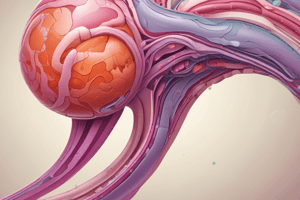Podcast
Questions and Answers
What is the function of Skene's Gland?
What is the function of Skene's Gland?
- Production of Ovum
- Hold Ovary
- Neutralize Acidity
- Secret Lubrication (correct)
Bartholin's Gland is located above the vagina.
Bartholin's Gland is located above the vagina.
False (B)
What is the site of fertilization?
What is the site of fertilization?
Fallopian Tube
Which of the following STDs can affect the fallopian tube?
Which of the following STDs can affect the fallopian tube?
What is the most common part of ectopic pregnancy?
What is the most common part of ectopic pregnancy?
The ___ is the organ where ovulation occurs.
The ___ is the organ where ovulation occurs.
Match the following terms related to the reproductive system:
Match the following terms related to the reproductive system:
Which glands are involved in lubrication and acidity neutralization?
Which glands are involved in lubrication and acidity neutralization?
Gonorrhea does not affect Bartholin's Gland.
Gonorrhea does not affect Bartholin's Gland.
What is the site of fertilization?
What is the site of fertilization?
The most common part of ectopic pregnancy occurs in the _____ of the Fallopian Tube.
The most common part of ectopic pregnancy occurs in the _____ of the Fallopian Tube.
What are the two STDs that affect the Fallopian Tube?
What are the two STDs that affect the Fallopian Tube?
What are the functions of the ovary?
What are the functions of the ovary?
What is the structure at the most distal part of the Fallopian Tube?
What is the structure at the most distal part of the Fallopian Tube?
Flashcards are hidden until you start studying
Study Notes
Vulva
-
Comprises two glands:
- Skene's Gland: Located between the urethral meatus, also known as paraurethral glands, responsible for secreting lubrication.
- Bartholin's Gland: Positioned below the vagina, referred to as para-vaginal glands, secretes fluids that help neutralize acidity.
-
Normal flora plays a role in maintaining micro-acidity in the vagina, important for health and preventing infections.
-
Gonorrhea can affect Bartholin's Gland, potentially leading to complications such as abscess formation.
Internal Reproductive
-
Fallopian Tube: Known as oviducts, uterine tubes, or salpinges.
- Key site for fertilization of the ovum.
- Most common location for ectopic pregnancy, particularly in the ampulla region.
-
Pelvic Inflammatory Disease (PID) can result in damage to the fallopian tubes, frequently caused by sexually transmitted diseases (STDs) like chlamydia and gonorrhea.
-
Fimbriae: Finger-like projections that help hold the ovary, with the infundibulum being the most distal part.
-
Ovary: Primary site for ovulation, where ova (eggs) are released.
- Plays a critical role in the ovarian cycle, which includes menstruation and fertilization.
- Development of ovarian structures:
- Graafian follicle: Mature follicle that releases the ovum.
- Corpus luteum: Structure formed post-ovulation, responsible for hormone secretion.
Vulva
-
Comprises two main glands: Skene's Gland and Bartholin's Gland.
-
Skene's Gland
- Located between the urethral meatus.
- Also referred to as paraurethral gland.
- Function: Secretes lubrication.
-
Bartholin's Gland
- Positioned below the vagina.
- Also known as para-vaginal gland.
- Functions: Secretes fluids and helps to neutralize vaginal acidity.
-
Normal flora in the vagina maintains mild acidity, which is crucial for health.
-
Gonorrhea can impact Bartholin's Gland, potentially leading to infections or abscess formation.
Internal Reproductive System
-
Fallopian Tube
- Also called oviducts, uterine tubes, or salpingos.
- Main site for fertilization of the ovum.
- Most common site for ectopic pregnancies, specifically in the ampulla.
- Treatments may include salpingectomy (removal of the tube).
-
Pelvic Inflammatory Disease (PID)
- Affects the fallopian tubes.
- Commonly caused by STDs such as chlamydia and gonorrhea.
-
Fimbriae
- Finger-like structures at the end of the fallopian tube.
- Assist in holding the ovary and are the most distal part of the tube.
- The infundibulum is the farthest section of the fimbriae.
-
Ovary
- Primary site for ovulation.
- Responsible for ovum production.
- Plays a key role in the menstrual cycle, including processes like fertilization, formation of Graafian follicles, and corpus luteum development.
- Functions include hormone secretion critical for female reproductive health.
Studying That Suits You
Use AI to generate personalized quizzes and flashcards to suit your learning preferences.



